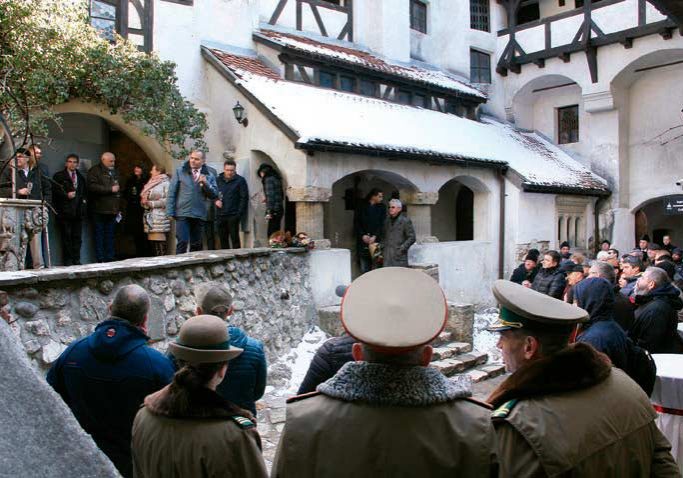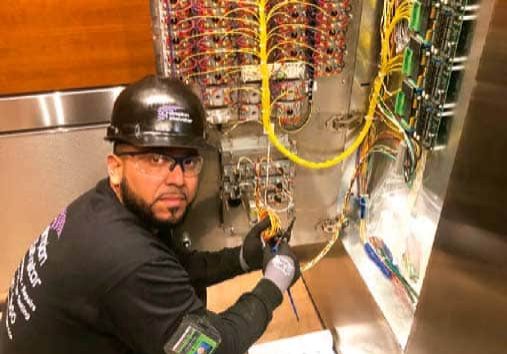High-pro le elevator incident offers lessons in emergency system testing and maintenance.
This is not about pointing out or piling on, but, rather, understanding that it is often someone else’s unfortunate situation that highlights gaps in our own processes. There is never a bad time to test your own emergency systems, elevator or otherwise, and see if they measure up — not just to code, but to your own standards of care.
In late January, a 53-year-old housekeeper was trapped in an elevator in a New York City (NYC) townhouse for three days, unbeknownst to the homeowner, who was not onsite. She became trapped in the residential elevator on a Friday and was rescued by the fire department Monday morning. An update to the story found the emergency elevator phone had been out of service, among other issues. She was reportedly dehydrated but otherwise in good condition, albeit a bit shaken. The only thing worse than experiencing an unfortunate situation yourself is having that same situation happen to someone you care about on your “watch.” Most of us have been there in some fashion. Sometimes that’s life, and those are the cards we’re dealt, but we should always walk away looking for how we can do better.
No one likes emergencies — not for yourself, your loved ones or your clients. The care factor goes a long way in emergency response. The human connection really does matter.
Not to pick on NYC, but this is not a new topic. The Real Deal published a two-part investigative series on elevator risk in the greater NYC area in January and February. Part one, “Elevated Risk,” covers specific accidents, lack of licensing requirements for elevator mechanics and missed red flags. Part two, “Elevated Risk: Malfunction at NYCHA,” focuses specifically on public housing, the pitfalls of falling short on elevator safety and plans announced in November 2018 to turn over the management of some of these apartment buildings to private companies. Both are worth a read.
As far as elevator entrapments, most people have either been stuck in an elevator or know someone who has. For those of us who have, it was likely for a much shorter time than the lady in the NYC townhouse. Hopefully, the person inside is afforded the ability to communicate with a live person, who can, at the bare minimum, let them know they aren’t alone in the world and confirm that help is on the way.
My personal entrapment experience was at a major U.S. airport and all of 20 min. This was nothing compared to a three-day stint, but 20 min. for me could be a lifetime for the next person. Thankfully, my elevator had a working emergency phone. While the woman who answered my call for help didn’t seem to care all that much, she confirmed someone would be coming to help. What we’re all looking for, especially in an emergency, is human connection.
Elevator Codes and Emergency Communications
Elevator codes and standards are developed by multiple o–cial bodies, including the American Society of Mechanical Engineers (ASME) and the International Code Council (ICC), the latter of which develops the International Building Code (IBC). The pertinent ASME code (in conjunction with the Canadian Standards Association [CSA]) related to emergency elevator communication in North America is theASME A17.1/CSA B44 Safety Code for Elevators and Escalators.
The emergency elevator communication code for IBC is IBC Elevators and Conveying Systems, Section 3001.
Codes vary by elevator use, as well. There are passenger, freight, construction and grain elevators. The code for a residential elevator generally differs from a commercial elevator, as the construction and use of residential elevators are quite different. While elevator code is nationally adopted in the U.S., the specific code year adopted by different states will vary. When new codes are published, the new code is only required in the states that adopt the new code year and only applies to new construction or elevator modernization. Some states automatically adopt. Then, there are the almighty “grandfather clauses,” sometimes referred to as “safe harbor provisions.” Due to these, some commercial elevators don’t have a phone in the cab at all. This is frequent and occurs when a building predates some code or standard going into effect yet meets certain criteria.
The same goes for compliance with the Americans with Disabilities Act (ADA) for older buildings. While it’s not always practical to make these changes, mere code compliance should not be set as the ultimate bar. Kings III Emergency Communications specializes in heightened emergency monitoring for elevator and other emergency phones. We’re here to educate and, hopefully, promote the need to go above and beyond code compliance.
The bulk of our emergency-phone monitoring sits in commercial o–ce buildings, multifamily communities, schools and storage facilities. We encourage everyone to test their phones regularly.
The main points of the ASME code for elevator emergency communications are:
- You must have a two-way communication system in the elevator, and it must be hands free (per the ADA).
- The phone must ring to authorized personnel, who can take appropriate action and are available 24/7, 365 days a year. It cannot ring to an automated answering system.
- The call must be answered within 45 s. If not, it must redirect to an offsite or onsite location.
- There must be a visual indicator, such as a light, that indicates the call has connected.
- The answering party must be able to identify your location, down to the elevator cab, without help from the elevator passenger.
- If there are two or more elevators, each cab must be able to place an emergency call simultaneously with another.
Side Note
Th e IBC is similar to the ASME code. Just this past year, an IBC update specifi cally developed to aid the hearing- and speech-impaired in communicating in an elevator entrapment was published. Similarly, ASME is currently fi nalizing the 2019 edition of A17.1/B44 to be published later this year. An update to Section 2.27 is focused on making the emergency communication system more accessible to passengers with hearing and/or speech impairments. Th e changes center on a (not necessarily video) camera that can see the cab floor in its entirety and a (not necessarily two-way) digital messaging system to enhance communication with entrapped passengers. It’s always important to note that this code will only apply to elevators permitted for construction or modernization (alteration) aft er the code is published and adopted by the state in which the elevator is located. It will not impact existing elevators not undergoing modernization. We continue to monitor progress on the fi nal iteration of that update, which will be published later this year.
Mere code compliance should not be set as the ultimate bar.
The Perfect Time to Test Your Elevator Phones
Th ere is no time like the present. Put your elevator phone to the test with our step-by-step instructions for comprehensively testing them to check for specifi cs, such as ability to locate the elevator without the help of the passenger. We encourage everyone to test their equipment and existing service monthly, at a minimum, and with the frame of mind that you, your loved one or your most important customer will be trapped in the elevator. Regardless of whether it passes code, ask yourself if it is up to the standard of care you expect and your customers deserve.
Time and again, we fi nd ourselves chatting with property managers who really aren’t sure who answers their emergency phones or the exact protocol in handling. If that’s you, you’re not alone. It’s understandable this isn’t something most of us ever think about (myself included) until we do. Th is is usually right about the time or just aft er we need it.
A few oft en overlooked items worth evaluating follow. First, passing inspection isn’t good enough. Th e “who” matters. Even if you have a working phone that passes inspection, you should ask some questions:
- Who’s on the other end of the line?
- How’s the call handled?
- What training have the emergency operators received? Are they specialized in emergency monitoring, or do they handle a wide variety of calls like a typical answering service? Will they stay on the line as long as a passenger needs them, or are they evaluated by how quickly they can wrap up a call?
- What about risk and liability mitigation?
- Can responding parties provide medical instruction?
Reactions
Entrapment reactions are varied: one person’s inconvenient or irritating situation can be another’s trigger for a panic attack or escalation of existing health issues. In a focus group we conducted with the Building Owners and Managers Association International, a former assistant fire-chief-turned-commercial-real-estate- investor and manager said it best. In recalling a story of an entrapped woman he helped rescue, he explained, “An elevator is probably the safest place you could be. It’s a building within a building. The trouble is, no one is thinking that when they’re stuck in one.”
We’ve handled the full gamut, with some calls lasting a short time and others, 90-plus min. like a recent call we had with an elderly woman on oxygen trapped in a Florida elevator. It’s important that the team answering calls for help can provide appropriate medical instruction and calm passengers when needed. Generic answering services have their place, but this isn’t it.
Language Translation
The U.S. is the melting pot of all melting pots, and that comes with an abundance of languages. Even those who speak fluent English as a second language may, when panicked, revert to their native language. It’s imperative that whomever is answering a call for help can provide that help to everyone, every time and in the language in which it’s needed.
Conclusion
Location, Location, Location
As mentioned, code requires that responding operators be able to identify caller location without the help of the passenger. Is your current elevator phone monitoring capable of this? Put it to the test.
False-Alarm Issues
False alarms are common, so you want a means of filtering them out as best you can to avoid dispatching emergency personnel when they aren’t needed. It’s a waste of their time; a hassle for you; and, in many cases, results in false alarm fines for multiple offenses.
Risk Mitigation
How do you verify and back up event details for incident reports and potential litigation? Do you currently record and keep backups of all emergency calls from your elevators? Are the emergency operators asking the right questions to verify health conditions and confirm there is no need for emergency medical services?
The Care Factor
No one likes emergencies — not for yourself, your loved ones or your clients. The care factor goes a long way in emergency response. The human connection really does matter. At the end of the day, it’s just people helping people.
Get more of Elevator World. Sign up for our free e-newsletter.







